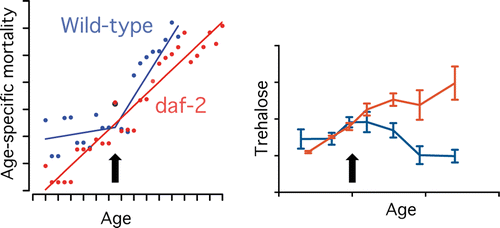What metabolism could reveal about aging and mortality

Why some people live much longer than others is an enduring mystery. Now, based on a study of a worm, scientists are getting one step closer to understanding longevity. They report in ACS' Journal of Proteome Research that the metabolic profiles of the worms could accurately predict how long they would live and that middle age could be a key turning point.
Other than addressing our curiosity—and apprehensions—about growing old, predicting longevity has practical applications for life insurance companies, retirement investing and health care planning. Current techniques that estimate how long people will live weigh a number of factors, including geographical location, family medical histories and lifestyle choices. To improve these predictions, researchers have started drawing from genetics, but DNA only tells part of the story. To fill in more blanks, Armand M. Leroi studied the metabolic profiles of the tiny worm Caenorhabditis elegans to see if they could find patterns related to life expectancy.
The researchers compared metabolic changes in normal worms with those of long-lived ones that had a genetic mutation. By profiling 26 metabolites, they could predict the worms' lifespans. The team also found that the two types of worms aged at different rates. When the worms with a normal lifespan hit middle age, their metabolic profiles indicated that they started getting older about 40 percent faster than when their long-lived counterparts hit middle age. The researchers say further work is needed to investigate how this happens.
More information: Sarah K. Davies et al. Metabolic Youth in Middle Age: Predicting Aging in Using Metabolomics , Journal of Proteome Research (2015). DOI: 10.1021/acs.jproteome.5b00442
Abstract
Many mutations and allelic variants are known that influence the rate at which animals age, but when in life do such variants diverge from normal patterns of aging? Is this divergence visible in their physiologies? To investigate these questions, we have used 1H NMR spectroscopy to study how the metabolome of the nematode Caenorhabditis elegans changes as it grows older. We identify a series of metabolic changes that, collectively, predict the age of wild-type worms. We then show that long-lived mutant daf-2(m41) worms are metabolically youthful compared to wild-type worms, but that this relative youth only appears in middle age. Finally, we show that metabolic age predicts the timing and magnitude of differences in age-specific mortality between these strains. Thus, the future mortality of these two genotypes can be predicted long before most of the worms die.



















